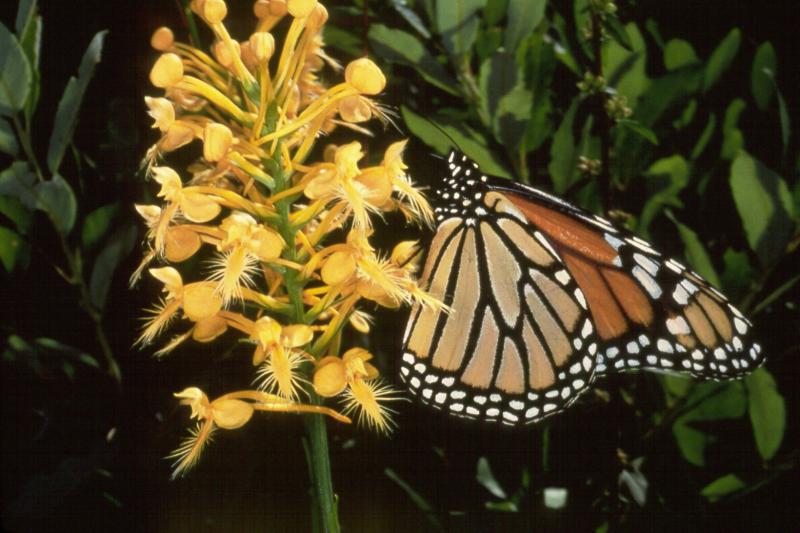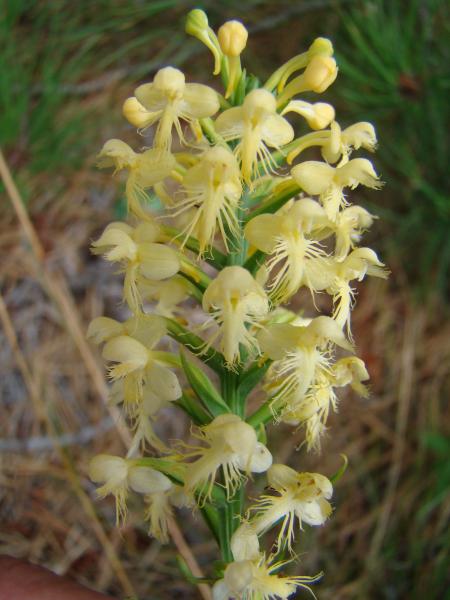Orange Fringed Orchid
Platanthera ciliaris (L.) Lindl.
- Class
- Monocotyledoneae (Monocots)
- Family
- Orchidaceae (Orchid Family)
- State Protection
- Endangered
Listed as Endangered by New York State: in imminent danger of extirpation in New York. For animals, taking, importation, transportation, or possession is prohibited, except under license or permit. For plants, removal or damage without the consent of the landowner is prohibited.
- Federal Protection
- Not Listed
- State Conservation Status Rank
- S1
Critically Imperiled in New York - Especially vulnerable to disappearing from New York due to extreme rarity or other factors; typically 5 or fewer populations or locations in New York, very few individuals, very restricted range, very few remaining acres (or miles of stream), and/or very steep declines.
- Global Conservation Status Rank
- G5
Secure globally - Common in the world; widespread and abundant (but may be rare in some parts of its range).
Summary
Did you know?
This orchid used to be much more common in New York with 40-50 historical occurrences. Development around New York City and Long Island drastically reduced numbers to the three small populations we know today.
State Ranking Justification
There are only three existing populations, none with more than 30 plants and none are protected. There were 40-50 historical occurrences but the majority of these have been extirpated by development.
Long-term Trends
Historically, there were 40-50 populations known mostly in southeastern New York but these have been reduced to 3 small populations on Long Island.
Conservation and Management
Threats
Plants along roadsides are threatened by improper mowing regimes and development, while more isolated populations are threatened by collection.
Conservation Strategies and Management Practices
This species needs disturbance to reduce competition from woody plants or more aggressive herbaceous plants, but too much direct disturbance to the plants will reduce or eliminate the population. Its habitat could be disturbed in the non-growing season to open it up for seed germination and colonization, but direct disturbance, especially from mowing, should be prevented during the growing season.
Research Needs
Research is currently needed to find out if the current populations can be recovered to more robust numbers.
Habitat
Habitat
In New York State Platanthera ciliaris has been collected from a fairly wide diversity of habitats, including pine barrens, mowed roadsides, red maple swamps, and wet meadows. Acidic and at least seasonally wet soils seem to be a common element (New York Natural Heritage Program 2010). Moist sandy and peaty meadows, marshes, prairies, pine savannas, open woods, wet wooded flats, seeping slopes, roadsides, dry wooded slopes, sphagnum bogs (FNA 2002). Bogs, peaty or sandy woods or thickets or dryish swales and slopes (Fernald 1970).
Associated Ecological Communities
- Dwarf shrub bog*
(guide)
A wetland usually fed by rainwater or mineral-poor groundwater and dominated by short, evergreen shrubs and peat mosses. The surface of the peatland is usually hummocky, with shrubs more common on the hummocks and peat moss throughout. The water in the bog is usually nutrient-poor and acidic.
- Highbush blueberry bog thicket*
(guide)
A wetland usually fed by rainwater or mineral-poor groundwater and dominated by tall shrubs and peat mosses. The most abundant shrub is usually highbush blueberry. The water in the bog is usually nutrient-poor and acidic.
- Mowed roadside/pathway
A narrow strip of mowed vegetation along the side of a road, or a mowed pathway through taller vegetation (e.g., meadows, old fields, woodlands, forests), or along utility right-of-way corridors (e.g., power lines, telephone lines, gas pipelines). The vegetation in these mowed strips and paths may be dominated by grasses, sedges, and rushes; or it may be dominated by forbs, vines, and low shrubs that can tolerate infrequent mowing.
- Patterned peatland*
(guide)
A large peatland whose surface forms a gentle slope with a mosaic of high and low areas (relative to water levels). These high and low areas occur as narrow or broad bands of vegetation and pools that extend perpendicular to the direction of water flow across the slope of the peatland. Peat moss (Sphagnum) is the most abundant plant.
- Pine barrens shrub swamp*
(guide)
A shrub-dominated wetland that occurs in shallow depressions in the coastal plain, often as the transition zone between a coastal plain pond shore and either pitch pine-scrub oak barrens or pitch pine-oak forest.
- Pitch pine-blueberry peat swamp*
(guide)
A swamp that occurs in shallow depressions in sand plains where peat has accumulated over a poorly drained sandy soil. This soil has a horizon cemented by iron oxide; the cemented horizon impedes drainage and causes seasonal flooding. The dominant tree is pitch pine. Gray birch and red maple are present at a low density. The canopy is open, with about 50 to 60 percent cover.
- Pitch pine-heath barrens*
(guide)
A shrub-savanna community that occurs on well-drained, sandy or rocky soils. The most abundant tree is pitch pine and the shrublayer is dominated by heath shrubs.
- Red maple-blackgum swamp
(guide)
A maritime, coastal, or inland hardwood swamp that occurs in poorly drained depressions, sometimes in a narrow band between a stream and upland. Red maple and blackgum are often codominant or blackgum may be the dominant tree. Pitch pine may occur on drier hummock islands in pine barrens settings.
- Successional blueberry heath*
A shrubland dominated by ericaceous (heath-like) shrubs that occurs on sites with acidic soils that have been cleared (for logging, farming, etc.) or otherwise disturbed.
* probable association but not confirmed.
Associated Species
- Acer rubrum
- Andropogon virginicus
- Clethra alnifolia (coastal sweet-pepperbush)
- Eupatorium sessilifolium (upland thoroughwort)
- Euthamia graminifolia (common flat-topped-goldenrod)
- Ilex glabra (inkberry)
- Maianthemum canadense (Canada mayflower)
- Nyssa sylvatica (black-gum, sour-gum)
- Osmunda cinnamomea
- Photinia
- Pinus rigida (pitch pine)
- Pycnanthemum muticum (short-toothed mountain-mint)
- Rhododendron viscosum (swamp azalea)
- Rhus glabra (smooth sumac)
- Rhynchospora capitellata (brownish beak sedge)
- Solidago rugosa
- Trientalis borealis
Range
New York State Distribution
This orchid ranged from the Rochester and Syracuse-Rome areas east to Eastern New York, Long Island and the New York City area, but its range has been greatly reduced. It is now considered extirpated in the New York City area and may be gone north of Long Island.
Global Distribution
This is an orchid of the Southeastern US, most common from the Virginias southeast to Arkansas and Texas and south to Florida. It is scattered and rare from Eastern Oklahoma and Missouri northeast to the Midwest, east to Maryland and north to New York and New England.
Identification Comments
General Description
Orange Fringed Orchids have a central stalk from 24 up to 100 centimeters tall, with two to four alternate, spreading to ascending, lanceolate leaves, abruptly reduced to bracts above. The many showy, orange flowers are borne in a dense spike, the lower end maturing first. The lip is 8 to 19 millimeters long, and has a ragged lower edge with many long, delicate fringes. The spur is slender and long, from 20 to 35 millimeters long, nearly equalling or exceeding the ovary, and pointed backwards (FNA 2002).
Best Life Stage for Proper Identification
Flowering specimens are best for identification, as flower color most easily distinguishes this species from Platanthera blephariglottis.
Similar Species
Platanthera cristata's flower has a spur only 5-9 mm long, and is smaller throughout than Platanthera ciliaris. Platanthera blephariglottis has white flowers.
Best Time to See
Orange-fringed Orchid flowers from mid-July through September, and the fruits may persist through December where there is no snow.
- Flowering
- Fruiting
The time of year you would expect to find Orange Fringed Orchid flowering and fruiting in New York.
Orange Fringed Orchid Images
Images of Similar Species
Taxonomy
Orange Fringed Orchid
Platanthera ciliaris (L.) Lindl.
- Kingdom Plantae
- Phylum Anthophyta
- Class Monocotyledoneae
(Monocots)
- Order Orchidales
- Family Orchidaceae (Orchid Family)
- Order Orchidales
- Class Monocotyledoneae
(Monocots)
- Phylum Anthophyta
Additional Common Names
- Orange Fringed Orchis
- Orange Orchid
- Yellow Fringed Orchid
Synonyms
- Blephariglottis ciliaris (L.) Rydb. ex Britt.
- Habenaria ciliaris (L.) R. Br.
Additional Resources
Best Identification Reference
Flora of North America Editorial Committee. 2002. Flora of North America, North of Mexico. Volume 26. Magnoliophyta: Liliidae: Liliales and Orchidales. Oxford University Press, New York. 723 pp.
Other References
Clemants, Steven and Carol Gracie. 2006. Wildflowers in the Field and Forest. A Field Guide to the Northeastern United States. Oxford University Press, New York, NY. 445 pp.
Crow, Garrett E. and C. Barre Hellquist. 2000. Aquatic and wetland plants of northeastern North America: A revised and enlarged edition or Norman C. Fassett's a manual of aquatic plants. Volume two angiosperms: Monocotyledons. The University of Wisconsin Press. Madison, Wisconsin. 456 pp.
Fernald, M.L. 1950. Gray's manual of botany. 8th edition. D. Van Nostrand, New York. 1632 pp.
Gleason, Henry A. and A. Cronquist. 1991. Manual of Vascular Plants of Northeastern United States and Adjacent Canada. The New York Botanical Garden, Bronx, New York. 910 pp.
Holmgren, Noel. 1998. The Illustrated Companion to Gleason and Cronquist's Manual. Illustrations of the Vascular Plants of Northeastern United States and Adjacent Canada. The New York Botanical Garden, Bronx, New York.
Mitchell, Richard S. and Gordon C. Tucker. 1997. Revised Checklist of New York State Plants. Contributions to a Flora of New York State. Checklist IV. Bulletin No. 490. New York State Museum. Albany, NY. 400 pp.
New York Natural Heritage Program. 2010. Biotics database. New York Natural Heritage Program. New York State Department of Environmental Conservation. Albany, NY.
New York Natural Heritage Program. 2024. New York Natural Heritage Program Databases. Albany, NY.
Newcomb, Lawrence. 1977. Newcomb's Wildflower Guide: An Ingenious New Key System for Quick, Positive Field Identification of the Wildflowers, Flowering Shrubs, and Vines of Northeastern and North-Central North America. Little, Brown and Company. Boston.
Weldy, T. and D. Werier. 2010. New York flora atlas. [S.M. Landry, K.N. Campbell, and L.D. Mabe (original application development), Florida Center for Community Design and Research http://www.fccdr.usf.edu/. University of South Florida http://www.usf.edu/]. New York Flora Association http://newyork.plantatlas.usf.edu/, Albany, New York
Links
About This Guide
Information for this guide was last updated on: August 28, 2019
Please cite this page as:
New York Natural Heritage Program. 2024.
Online Conservation Guide for
Platanthera ciliaris.
Available from: https://guides.nynhp.org/orange-fringed-orchid/.
Accessed July 26, 2024.


